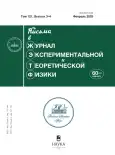Tsallis–Cirto entropy of black hole and black hole atom
- 作者: Volovik G.E1
-
隶属关系:
- Landau Institute for Theoretical Physics
- 期: 卷 121, 编号 3-4 (2025)
- 页面: 260-262
- 栏目: Articles
- URL: https://bakhtiniada.ru/0370-274X/article/view/286094
- DOI: https://doi.org/10.31857/S0370274X25020158
- EDN: https://elibrary.ru/VLAYAK
- ID: 286094
如何引用文章
详细
The quantum tunneling processes related to the black hole determine the black hole thermodynamics. The Hawking temperature is determined by the quantum tunneling processes of radiation of particles from the black hole. On the other hand, the Bekenstein-Hawking entropy of the black hole is obtained by consideration of the macroscopic quantum tunneling processes of splitting of black hole to the smaller black holes. These tunneling processes also determine the composition rule for the black hole entropy, which coincides with the composition rule for the non-extensive Tsallis-Cirto δ = 2 entropy. This composition rule suggests that the mass spectrum of the black hole is equidistant, M = NM0. Here N is an integer number and M0 = √2mP is the mass quantum expressed via the reduced Planck mass mP. The Bekenstein–Hawking entropy of the black hole with mass M = NM0 is SBH(N) = N2.
作者简介
G. Volovik
Landau Institute for Theoretical Physics
编辑信件的主要联系方式.
Email: zhvictorm@gmail.com
Chernogolovka, Russia
参考
- S. Nojiri, S. D. Odintsov, and V. Faraoni, Phys. Rev. D 104, 084030 (2021).
- S. Nojiri, S. D. Odintsov, and V. Faraoni, Phys. Rev. D 105, 044042 (2022).
- A. Anand and S.N. Gashti, arXiv:2411.02875.
- S. N. Gashti, B. Pourhassan, and I. Sakalli, arXiv:2412.12137 [hep-th].
- C. Tsallis and L. J. L. Cirto, Eur. Phys. J. C 73, 2487 (2013).
- C. Tsallis, Entropy 22, 17 (2020).
- M. P. Dabrowski, Entropy 26, 814 (2024).
- M. K. Parikh and F. Wilczek, Phys. Rev. Lett. 85, 5042 (2000).
- K. Srinivasan and T. Padmanabhan, Phys. Rev. D 60, 024007 (1999).
- G. E. Volovik, JETP Lett. 69, 705 (1999).
- E. Keski-Vakkuri and P. Kraus, Nucl. Phys. B 491, 249 (1997).
- G. E. Volovik, JETP 135, 388 (2022).
- S. W. Hawking and G. T. Horowitz, Phys. Rev. D 51, 4302 (1995).
- G. E. Volovik, Symmetry 16, 763 (2024).
- G. E. Volovik, arXiv:2411.01892.
- S. Hawking, Mon. Not. R. Astron. Soc. 152, 75 (1971).
- P. Chen, New Astron. Rev. 49, 233 (2005).
- V. Faraoni, Am. J. Phys. 85, 865 (2017).
- S. Rasanen and E. Tomberg, JCAP 01, 038 (2019).
- S. Profumo, arXiv:2405.00546.
- C. Rovelli and F. Vidotto, arXiv:2407.09584.
- Y. Ch. Ong, arXiv:2412.00322.
- M. A. Markov, JETP 24, 584 (1967).
- J. D. Bekenstein, Lett. Nuovo Cim. 11, 467 (1974).
- V. F. Mukhanov, JETP Lett. 44, 63 (1986).
- H. A. Kastrup, Phys. Lett. B 413, 267 (1997).
- I. B. Khriplovich, Phys. Atom. Nucl. 71, 671 (2008).
- G. Dvali and C. Gomez, Fortsch. Phys. 59, 579 (2011).
- C. Kiefer, J. Phys.: Conf. Ser. 1612, 012017 (2020).
- B. Bagchi, A. Ghosh, and S. Sen, Gen. Relativ. Gravit. 56, 108 (2024).
- A. Barvinsky, S. Das, and G. Kunstatter, Phys. Lett. B 517, 415 (2001).
- A. Barvinsky, S. Das, and G. Kunstatter, Found. Phys.
- , 1851 (2002).
- B. R. Majhi and E. C. Vagenas, Phys. Lett. B 701, 623 (2011).
- M. Cvetic, G. W. Gibbons, and C. N. Pope, Phys. Rev. Lett. 106, 121301 (2011).
- M. Visser, JHEP 06, 023 (2012).
补充文件









